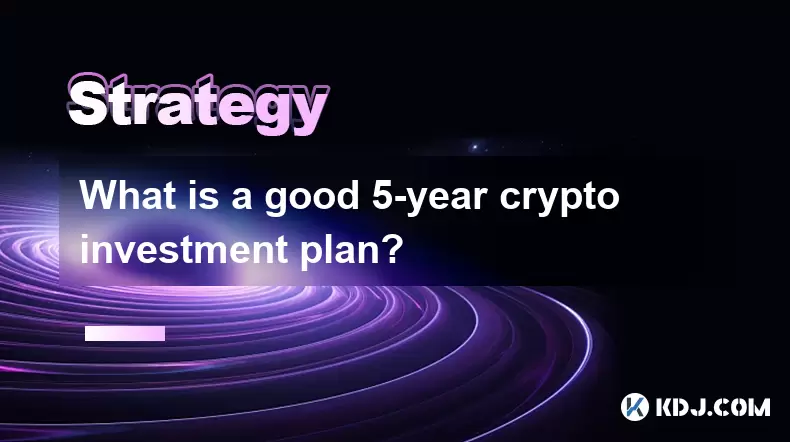-
 bitcoin
bitcoin $120167.907534 USD
1.27% -
 ethereum
ethereum $4468.611945 USD
2.53% -
 xrp
xrp $3.013607 USD
1.80% -
 tether
tether $1.000549 USD
-0.01% -
 bnb
bnb $1092.592149 USD
6.28% -
 solana
solana $231.391244 USD
4.59% -
 usd-coin
usd-coin $0.999699 USD
-0.04% -
 dogecoin
dogecoin $0.259020 USD
4.30% -
 tron
tron $0.342747 USD
0.34% -
 cardano
cardano $0.860977 USD
1.07% -
 hyperliquid
hyperliquid $50.155412 USD
5.34% -
 chainlink
chainlink $22.637678 USD
0.46% -
 ethena-usde
ethena-usde $1.000528 USD
-0.07% -
 avalanche
avalanche $30.613779 USD
-0.07% -
 stellar
stellar $0.403905 USD
0.94%
What is a good 5-year crypto investment plan?
A 5-year crypto investment plan focuses on long-term growth through diversified asset allocation, periodic rebalancing, and passive income strategies like staking and yield farming.
Jul 16, 2025 at 03:28 am

Understanding the Foundations of a 5-Year Crypto Investment Strategy
A 5-year crypto investment plan is a structured approach to investing in digital assets with a medium-term horizon. Unlike short-term trading strategies that focus on daily or weekly price fluctuations, a 5-year plan emphasizes patience, research, and diversification. This type of strategy is particularly appealing to investors who believe in the long-term potential of blockchain technology and cryptocurrencies but want to manage risk effectively.
One of the key elements of this plan is understanding market cycles. Cryptocurrency markets are known for their volatility, and a 5-year timeframe allows investors to ride out bear markets and benefit from potential bull runs. Historical data shows that major cryptocurrencies like Bitcoin (BTC) and Ethereum (ETH) have seen significant gains over five-year periods despite short-term downturns.
Asset Allocation and Diversification in a 5-Year Plan
Diversification is crucial in any investment plan, and a 5-year crypto investment approach is no exception. The goal is to spread investments across different types of cryptocurrencies to reduce exposure to any single asset. This includes:
- Blue-chip cryptocurrencies like Bitcoin, Ethereum, and Binance Coin (BNB), which have proven track records and strong ecosystems.
- Layer-1 blockchains such as Solana (SOL), Cardano (ADA), and Polkadot (DOT) that aim to improve scalability and interoperability.
- DeFi tokens like Uniswap (UNI) and Aave (AAVE) that offer exposure to decentralized finance.
- NFT and metaverse-related assets, which are still emerging but could grow significantly over the next five years.
Each category should have a defined allocation percentage based on risk tolerance and market outlook. For example, 40% might be allocated to blue-chip coins, 25% to layer-1 blockchains, 20% to DeFi, and 15% to NFTs or niche sectors.
Rebalancing and Risk Management Over Time
Over the course of five years, it's essential to rebalance your portfolio periodically to maintain your target allocation. Market fluctuations can cause certain assets to dominate your portfolio, increasing risk. Rebalancing typically involves selling overperforming assets and reinvesting in underperforming ones.
- Set a rebalancing schedule, such as every 6 or 12 months.
- Use stop-loss orders or limit orders to protect against sudden price drops.
- Monitor macroeconomic factors like inflation, interest rates, and regulatory changes that can affect crypto markets.
Risk management also involves position sizing. No single asset should exceed a certain percentage of your total portfolio—typically 5–10%. This ensures that even if one asset fails, it won’t significantly impact your overall investment.
Staking, Yield Farming, and Passive Income Opportunities
A 5-year investment plan can also include passive income strategies such as staking and yield farming. These methods allow investors to earn returns on their holdings without selling them.
- Staking involves locking up coins like Ethereum, Cardano, or Tezos (XTZ) to support network operations and earn rewards.
- Yield farming involves providing liquidity to decentralized exchanges (DEXs) like Uniswap or Curve Finance in exchange for fees and token rewards.
- Lending platforms like Aave or Compound allow users to lend out their crypto and earn interest.
It's important to understand the risks involved, such as impermanent loss in yield farming or smart contract vulnerabilities. Always research the platforms and protocols you use and consider using audited and well-established platforms.
Tracking Performance and Keeping Records
Keeping accurate records is essential for evaluating the success of your 5-year crypto investment plan. Use portfolio tracking apps like CoinMarketCap, CoinGecko, or Blockfolio to monitor performance in real time.
- Record all transactions, including buys, sells, staking rewards, and gas fees.
- Track tax implications, especially if you're based in a jurisdiction where crypto gains are taxable.
- Review performance annually to assess whether your strategy is on track or needs adjustments.
Some investors also use spreadsheets or financial software to create custom reports and visualize growth trends. Accurate record-keeping not only helps with tax reporting but also informs future investment decisions.
FAQs
Q: Should I invest a lump sum or dollar-cost average over the 5 years?A: Both strategies have advantages. Dollar-cost averaging (DCA) reduces the risk of entering the market at a high point. Lump-sum investing can potentially yield higher returns if the market rises consistently over time. Consider your risk tolerance and market outlook before deciding.
Q: Can I include stablecoins in my 5-year crypto investment plan?A: While stablecoins offer stability, they generally do not provide long-term growth. However, they can be used as a hedging tool during volatile periods or to accumulate assets when prices drop.
Q: What if a project I invest in fails within the 5-year period?A: That’s a risk inherent in crypto investing. To mitigate this, limit exposure to any single project, conduct thorough research, and stay updated on project developments and community sentiment.
Q: How often should I review my crypto investment plan?A: At a minimum, review your plan quarterly or semi-annually. Major market events, regulatory changes, or technological upgrades may require more frequent reviews to ensure your strategy remains aligned with your goals.
Disclaimer:info@kdj.com
The information provided is not trading advice. kdj.com does not assume any responsibility for any investments made based on the information provided in this article. Cryptocurrencies are highly volatile and it is highly recommended that you invest with caution after thorough research!
If you believe that the content used on this website infringes your copyright, please contact us immediately (info@kdj.com) and we will delete it promptly.
- BlockDAG, DOGE, HYPE Sponsorship: Crypto Trends Shaping 2025
- 2025-10-01 00:25:13
- Deutsche Börse and Circle: A StableCoin Adoption Powerhouse in Europe
- 2025-10-01 00:25:13
- BlockDAG's Presale Buzz: Is It the Crypto to Watch in October 2025?
- 2025-10-01 00:30:13
- Bitcoin, Crypto, and IQ: When Genius Meets Digital Gold?
- 2025-10-01 00:30:13
- Stablecoins, American Innovation, and Wallet Tokens: The Next Frontier
- 2025-10-01 00:35:12
- NBU, Coins, and Crypto in Ukraine: A New Yorker's Take
- 2025-10-01 00:45:14
Related knowledge

Practical parameter settings for a Bitcoin multi-timeframe moving average system
Sep 18,2025 at 10:54pm
Optimizing Timeframe Combinations for Bitcoin Trading1. Selecting appropriate timeframes is crucial when building a multi-timeframe moving average sys...

How can I filter out false breakouts in Dogecoin high-frequency trading?
Sep 22,2025 at 01:00am
Understanding False Breakouts in Dogecoin Trading1. A false breakout occurs when Dogecoin's price appears to move beyond a defined support or resistan...

Techniques for identifying tops and bottoms in the Bitcoin on-chain NVT model
Sep 20,2025 at 07:54pm
Understanding the NVT Model in Bitcoin Analysis1. The Network Value to Transactions (NVT) ratio is often described as the 'P/E ratio' of the cryptocur...

What does the surge in open interest in Bitcoincoin futures mean?
Sep 20,2025 at 11:18pm
Understanding the Surge in Dogecoin Futures Open Interest1. A surge in open interest within Dogecoin futures indicates a growing number of active cont...

How can I use the Ethereum USDT premium to gauge market sentiment?
Sep 18,2025 at 11:55pm
Understanding the Ethereum USDT Premium1. The Ethereum USDT premium refers to the price difference between USDT (Tether) traded on Ethereum-based plat...

What should I do if Ethereum staking yields decline?
Sep 20,2025 at 06:18am
Understanding the Causes Behind Declining Ethereum Staking Yields1. The Ethereum network transitioned to a proof-of-stake consensus mechanism with the...

Practical parameter settings for a Bitcoin multi-timeframe moving average system
Sep 18,2025 at 10:54pm
Optimizing Timeframe Combinations for Bitcoin Trading1. Selecting appropriate timeframes is crucial when building a multi-timeframe moving average sys...

How can I filter out false breakouts in Dogecoin high-frequency trading?
Sep 22,2025 at 01:00am
Understanding False Breakouts in Dogecoin Trading1. A false breakout occurs when Dogecoin's price appears to move beyond a defined support or resistan...

Techniques for identifying tops and bottoms in the Bitcoin on-chain NVT model
Sep 20,2025 at 07:54pm
Understanding the NVT Model in Bitcoin Analysis1. The Network Value to Transactions (NVT) ratio is often described as the 'P/E ratio' of the cryptocur...

What does the surge in open interest in Bitcoincoin futures mean?
Sep 20,2025 at 11:18pm
Understanding the Surge in Dogecoin Futures Open Interest1. A surge in open interest within Dogecoin futures indicates a growing number of active cont...

How can I use the Ethereum USDT premium to gauge market sentiment?
Sep 18,2025 at 11:55pm
Understanding the Ethereum USDT Premium1. The Ethereum USDT premium refers to the price difference between USDT (Tether) traded on Ethereum-based plat...

What should I do if Ethereum staking yields decline?
Sep 20,2025 at 06:18am
Understanding the Causes Behind Declining Ethereum Staking Yields1. The Ethereum network transitioned to a proof-of-stake consensus mechanism with the...
See all articles










































































